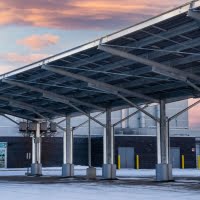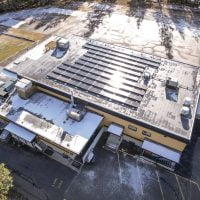WHAT SHOULD I DO WHEN THERE IS SNOW ON MY SOLAR PANELS?
Solar panels are designed to work in all weather conditions, including snowfall. Solar panels have been designed with the ability to withstand winter weather, the cold and frosting conditions won’t damage them. However, if snow accumulates on the panels, it can reduce the amount of energy they produce. This is because the snow can block sunlight from reaching the panels. The reduced energy production due to snow would be accounted for in your solar panel design. Still, some people may choose to remove snow from their panels to maximize energy production, but it is not strictly necessary.
At Energy Economics, we do not recommend removing snow as there are risks involved – accessing the roof in winter can be dangerous and if you are not careful you could damage your solar panels (scratching the glass, loosening clamps) and void your warranties. Also, solar production is typically very low in areas when there is snow accumulation. The added energy production may not be worth the effort. A five-year study by Northern Alberta Institute of Technology (NAIT) found the overall energy loss due to snow accumulating on panels was only 5 percent (**A link to the NAIT study is here: TechLifeToday ).
What if I want to remove the snow from my solar panels?
The best method for removing snow from solar panels depends on the design of the system and the amount of snow.
Here are a few methods* that people commonly use to safely remove snow from solar panels:
- Snow Rake: This is a long-handled tool with a plastic or metal blade at the end that can be used to gently push snow off the panels from the ground. To prevent scratching the solar glass, you should wrap the blade in foam or replace the head with a rubber scraper.
- Soft-bristled Brush: Soft-bristled brush can also be used to gently sweep off the snow.
- Warm Water: Spraying warm water on the panels can help to melt the snow and ice, making it easier to remove.
- Heating Element: If you live in a location that frequently experiences heavy snowfall, it may be worth considering installing a heating element or anti-snow system on the panels to prevent snow from accumulating in the first place.
It is important to note that you should not climb on the roof to remove snow if you are not a trained professional, as it can be dangerous.
*This is not an endorsement of any of the methods listed. Use at your own risk.
Will snow just slide off my roof?
The angle, or pitch, of a roof can affect how easily snow and ice slide off. A steeper pitch will generally cause snow and ice to slide off more easily than a shallower pitch. A roof pitch of more than 30 degrees (7/12) is considered steep and snow is more likely to slide off easily.
However, a steep roof pitch alone does not guarantee that snow and ice will slide off easily. Other factors such as the type of roofing material, the quality of the roofing system, and the location of the roof (i.e. trees, buildings or other nearby structures) can also affect how easily snow and ice slide off. The presence of snow guards or heated elements, as well as the quality of the installation are also important factors.
If you live in an area that frequently experiences heavy snowfall and you have a sloped roof, it may be worth considering installing snow guards to prevent snow and ice from sliding off the roof and causing damage or injury. Snow guards work by creating a barrier that slows down the movement of snow and ice on the roof, allowing it to melt or slide off gradually, rather than all at once. They can be made from a variety of materials, including plastic, metal, and even rubber.
It is important to consult with a roofing professional or solar installer to determine if snow guards are necessary for your roof and what type of snow guards would be best for your specific situation.


